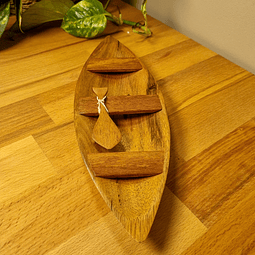Dimensions (height x width x depth): 26 x 47 x 10 cm
Weight: 0.10 kg
Origin: State of Pernambuco (Northeast Brazil)
History: Marcos Paulo Lau da Costa (or Marcos de Sertânia, named after the city where he lives) is one of the most important wood sculptors in Pernambuco, one of the poorest states in Brazil, often ravaged by drought. His best-known sculptures depict the dog “Baleia”, a character from the 1938 book “Vidas Secas”, by writer Graciliano Ramos, considered one of the greatest classics of Brazilian literature.
“Whale” was a squalid dog that accompanied a family that emigrated on foot from the interior of the northeastern region, seeking to escape drought and hunger, going through dramatic situations along their journey. With a work marked by drama, Marcos exposes, through wood, the anguish caused by the drought in the bodies of severely thin, fleshless characters, expressing the suffering and desolation of the backlands. “I experienced all of this and put it into my work.”
As a boy, he lived in a rural area, and became familiar with art during frequent visits to his grandfather and uncles' house when he went to the city, as the art of carving wood for the production and sale of small sculptures and household utensils was a family tradition. From the curious investigation of the tools, learning began. “Nobody had time to teach.” Thus, Marcos made attempts to reproduce what his elders did: the figure of the ox, the cow, an ox cart loaded with firewood, water, things he witnessed in the backlands. But everything he did in the beginning was finer than the sculptures of his elders, who said everything was wrong. But he persisted and continued sculpting, and his different sculptures became his trademark.
And that's how his renowned piece began to reach the world: “People just started ordering the dog because they thought it was a beautiful piece or they had and liked dogs.” From then on, it never stopped. His pieces are spread across private collections throughout Brazil and abroad, and have been compared to the Brazilian sculptor Portinari and the Italian artist and sculptor Amedeo Modigliani.
Today he creates work and income opportunities for ten people close to him, and around five independent artisans who help him and, simultaneously, develop their own art, generating income in a region that, more than 80 years after the events narrated in “Vidas Secas” , still presents challenges for the support of its residents.









